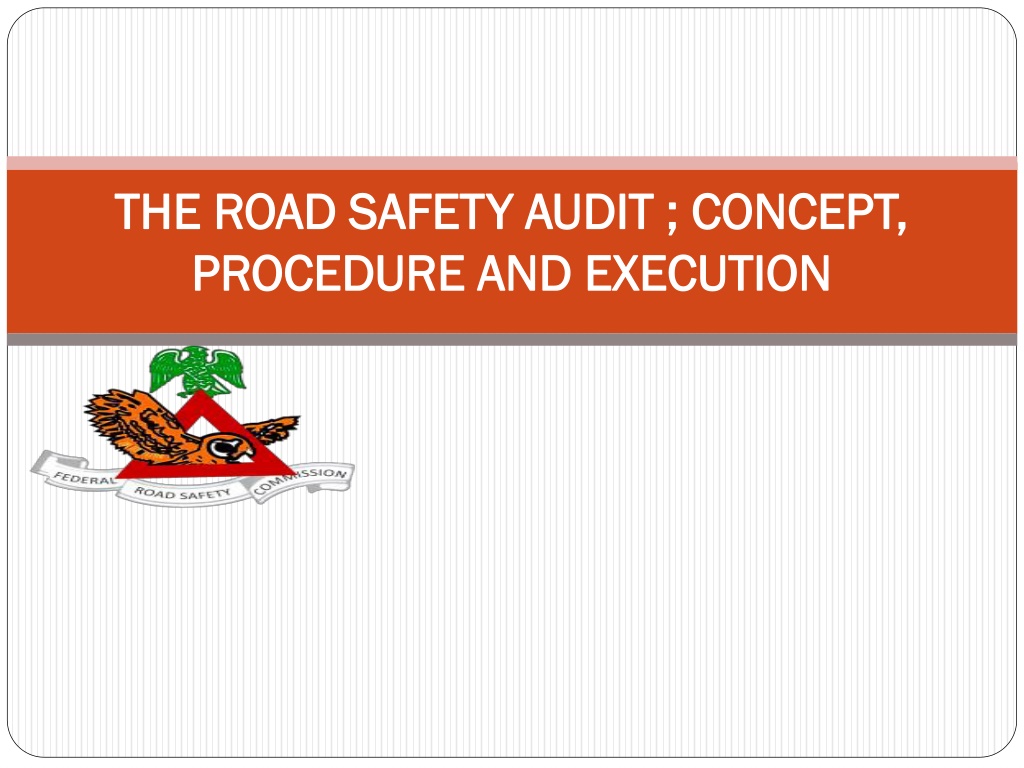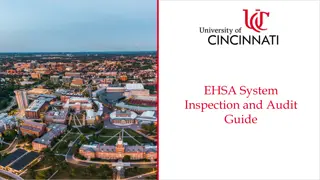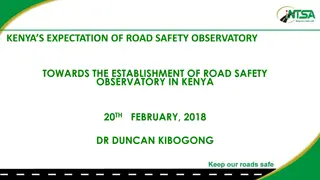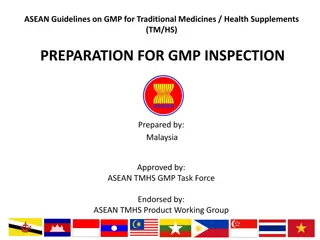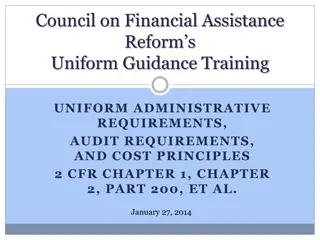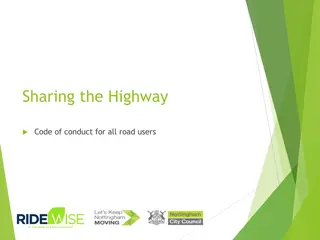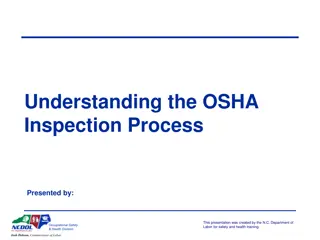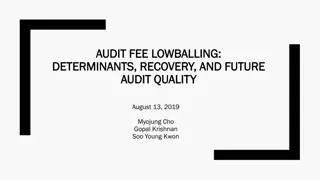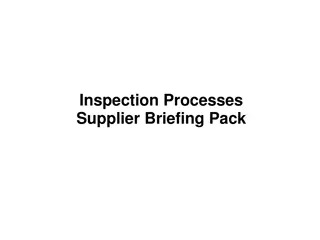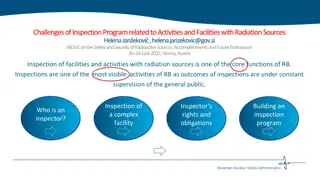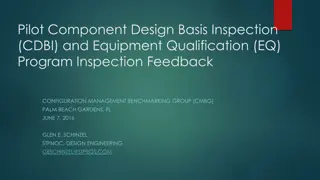Understanding Road Safety Audit and Inspection Concepts
Road Safety Audit (RSA) and Road Safety Inspection (RSI) play important roles in evaluating and improving road safety infrastructure. While RSA focuses on new road design and construction, RSI assesses existing roads periodically. This article discusses the differences between RSA and RSI, their procedures, and their significance in enhancing road safety.
Download Presentation

Please find below an Image/Link to download the presentation.
The content on the website is provided AS IS for your information and personal use only. It may not be sold, licensed, or shared on other websites without obtaining consent from the author. Download presentation by click this link. If you encounter any issues during the download, it is possible that the publisher has removed the file from their server.
E N D
Presentation Transcript
THE ROAD SAFETY AUDIT ; CONCEPT, THE ROAD SAFETY AUDIT ; CONCEPT, PROCEDURE AND EXECUTION PROCEDURE AND EXECUTION
Introduction Introduction Road Safety Audit (RSA) and Road Safety Inspection (RSI) are used to test the safety of the road infrastructure. These two words are different from each other but are interchangeably used by many. The RSA is used for design and construction of new roads /rehabilitation of existing of roads, whereas the RSI is used for evaluating existing roads. The aim of RSA is to improve the road safety before the road is built or reconstructed. At present not many RSA are carried out in Nigeria. In other country the RSA has shown its road safety value. The RSI also contribute to road safety. This is carried out periodically on an entire road network, and interim inspection on road section that have an above average number of crashes and on road structure where there are structural failures and damage as result of crashes.
Background. Background. Road safety was established in 1988 and was charged among others with responsibility of recommending works and devices. This responsibility registers the stake of the Federal Road Safety in the procurement, operation and maintenance of road infrastructure to step down the risking wave of RTC. In view of the foregoing, to ensure effective and efficient implementation of the responsibility there is need for RSA and RSI. Inadvertently, this duty was performed in the PRS department as part of its research activities from 1988 to 2009.
Background Cont. Background Cont. The introduction of the RTSSS of which its activities includes fleet inspection of vehicles brought the idea of professionalizing the inspection of road infrastructure and architecture, including the vehicle inspection. This prompted the establishment of Safety Engineering Department (SED) in 2009. Since then, the department has witnessed various re- organizations and reforms. Presently this important section of the Corps is addressed as Corps Safety Engineering Office code named COSEN.
Background Cont. Background Cont. COSEN carry out its activities through three major units, namely; 1. Vehicle Inspection and Certification 2. Accident Investigation and Analysis 3. Traffic Engineering In the structure the RSA and RSI (HI) are domiciled with the Traffic Engineering. In most cases RSA and RSI have always been mistaken to mean the same thing because of similarity in approach and overall objective. This fact sheet will discuss both RSA and RSI and the road effect they may have.
OBJECTIVE OBJECTIVE At the end of the lecture participants are expected to 1. know what road safety audit is 2. Differentiate between RSI and RSA 3. Define RSA and RSI 4. Know the processes and procedure require for carrying out RSA 5. Know some of the equipment use in RSA 6. Know the challenges and way forward 7. Understand the roles of road safety auditors
CONCEPT CONCEPT What are RSAs and RSIs Both RSA and RSI examine the road infrastructure exclusively for its road safety. RSA is carried out to test the design of the new roads or of the reconstruction of existing road. The examination or test of an existing road is called the RSI.
DEFINATION OF RSA DEFINATION OF RSA It is planned safety performance examination of future Road Intercession and other components by an independent audit team, to ensure safety during use. It qualitatively, quantitatively and frictionally analyzes the road structure and report on potential road safety issues and identifies opportunities for improvement for all road users. Van Schagan (2000) defines RSA as formal standardized procedure in other to reach an independent assessment of the possible road safety consequences of the design. An RSA has a preventive character and aims to signal any potential road safety problems before the infrastructure is actually built and to make suggestions for improvement. RSA can therefore be defined as a prevalence assessment of road infrastructure from its planning stage through construction to ensure that the safety concerns are addressed through critical examination of designs and ongoing construction works before the structure is commissioned for use. The level is cheaper than recommendation for RSI.
Road Safety Inspection The RSI involves teams of experts that visually inspect the existing road infrastructure or road network for different forms of fault regularly and systematically. This are usually done using checklist that are similar to those used in RSA. The European directive 2008/96/EG defines RSI as an ordinary periodic assessment of road features and deficiencies which from a road safety perspective make maintenance necessary (EP & R 2008).
Cont. it is also defined by (Mocsair, T. et al, 2006) as; A preventive tool, Consisting of a regular, systematic, on-site inspection of existing roads, covering the whole road network, Carried out by trained safety expert teams Resulting in a formal report on detected road hazards and safety issues Requiring a formal responds by the relevant road authority.
PRINCIPLE OF RSA AND RSI PRINCIPLE OF RSA AND RSI 1. The elements included in the road safety inspections should stand as risk factors for accident or injuries. 2. Inspections should be standardized and designed to ensure that all elements included are covered and are assessed in an objective manner. Initial stages of implementation checklist may be helpful. 3. Both RSA and RSI are intended to be used by road authorities. RSA involves in the design of road traffic plans and is always done by an independent audit team carrying out RSA. In addition to the RSA an RSI involves two or more road safety experts who carry out inspection cost and benefit of an RSA and RSI.
IMPORTANCE OF RSA AND RSI IMPORTANCE OF RSA AND RSI The major benefits of RSA and RSI are implicated in the cost saved on crashes that have been prevented by audit recommendations. Other qualitative benefits include: Reduce risk of crashes and repair works. Reduction of total project cost. Creation of greater awareness of road safety and quality in design processes. Provision of better facilities for vulnerable road users. Contribute towards achieving better road safety targets. Guarantee better standard and design guideline.
RSA/RSI COST Cost can vary greatly depending on the size of the project and the phase in which audit take place. There are two major costs (Direct and Indirect) Direct Cost: These include time spent by auditors and the extra time the designers need to include recommendations in the design. Indirect Cost: These are the extra costs of construction and reconstruction activities that result from audit recommendations.
IMPLIEMENTATION IMPLIEMENTATION In Nigeria many road agencies, designers, contractors and road authorities are yet to key into road safety audit scheme for fear of perceived implications. In Nigeria the federal ministry of works has consistently worked with federal ministry of works in this regards. Implementation of RSA typically include the following steps 1. Selecting or identifying projects from different stages of high way procurement (planning to operation) 2. Management approval 3. Selecting RSA team 4. Sensitization of RSA team 5. Gathering information needed to conduct audit 6. Conducting the audit
Best Practices Best Practices The guidelines for good RSI, suggested by Elvik (2006) consist of seven items: 1. The elements included in road safety inspection should stand as risk for factors for accident or injuries; 2. Inspections should be standardized as designed to ensure that all elements included are covered and are accessed in objective manner. Check list maybe helpful. 3. Checklist for RSI should include the following cases of recognized important elements. The quality of traffic signs with respect to their need and to whether they are correctly placed or legible in the dark The quantity road markings in particular whether they visible or consistent with traffic signs.
Best Practices Cont. Best Practices Cont. The quantity of the road surface characteristics in particular with respect to friction (macro and micro texture) and evenness The adequacy of sight distances and the absence of permanent or temporary obstacles that prevent timely observation of road or other road users. The presence of road side traffic hazards near the carriageway, such as trees, exposed rocks, drainage pipes and culverts, steep embankment slope and so on. Aspect of traffic operation, in particular if drivers speed are adequate to local conditions and to function of the road. These include the suitability of the road to its function and adequacy of space for current traffic and separation between motorized and vulnerable road users.
Best Practices Cont. Best Practices Cont. 4.For each element included in inspection, a standardization approach should be made by applying the following categories: a. The item represents the traffic hazard that should be treated immediately. A specific treatment should then be proposed. b. The item is not in a perfectly good condition or deviate slightly from current standards, but no short item is needed to correct it. Further observations are recommended c. The item is in good condition and in accordance with current standards
Best Practices Cont. Best Practices Cont. 5. RSI should state their findings and propose safety measures by means of standardized reports. 6. Inspectors should be formally qualified; they should meet regularly to ensure a uniform application of safety principles. must be able to determine direction of internal forces have knowledge of the behavior of construction materials be able to determine source of tension and structural failures knowledge of mechanics and statics knowledge of survey and measurement knowledge of soil knowledge of hydraulics and hydrology be able to sketch and read design drawings vast in road safety
Best Practices Cont. Best Practices Cont. 7. Therefore inspection team should consist of experience road safety personnel and engineers while the team leader should be a civil engineer related professionals that have good understanding of material properties, statics and mechanics, know nomenclatures of road infrastructure element and be able to read and interpret design drawings. Experienced register /certified engineer from among the list below {five to 10years professional qualification with road safety experience is essential} Civil Engineer Building engineer Land surveyor Agricultural engineer Structural engineer Transportation engineer
DUTIES OF DESIGN TEAM LEADERS AND DUTIES OF DESIGN TEAM LEADERS AND AUDIT TEAM LEADERS AUDIT TEAM LEADERS DTL (Design Team Leader) DTL (Design Team Leader) ATL (Audit Team Leaders) ATL (Audit Team Leaders) Pre audit meeting Communicate information to team members Determine the scope of and parameter for Road Safety Audits Assign roles to team members Preparation of report Post inspection meeting with road owner and designer to ensure that audit is within the scope planned for. Balance activities of the design team with the information requirement and final output of RSA team Must explain to the design team the importance of RSA process Provide the proper information to the RSA team He is to expedite request from RSA team He is to establish procedures for incorporating back into the project the RSA team input
Responsibilities Of Road Safety Auditors Responsibilities Of Road Safety Auditors Auditors are expected to fully understands RSA policies It is their role to understand the parameters of the audit to cover It is their responsibilities to identify specific safety issues When in road life cycle to carry out Audit Suggest potential solutions to any safety concerns The RSA team is responsible for reporting on all safety concerns identified even if the terms may be considered controversial Well defined roles for audit team members which is communicated to both the design team and audit team will smoothen out the relationship between the auditors and the designers. Lastly, there should be follow up of RSA and RSI after some time to check if the proposed measure have been implemented or not
Types Of Road Safety Audits Grouped By Types Of Road Safety Audits Grouped By Phase And Stages Phase And Stages Planning Preliminary Design Road Safety Audits Pre- Construction Work Zone Audit Construction Road Safety Audits Construction stage audit Pre- Opening audit Post Construction Road Safety Audits Existing Road Inspection
Types Of Road Safety Audit Group By Phases And Types Of Road Safety Audit Group By Phases And Stage With Probable Recommendations For Changes Stage With Probable Recommendations For Changes From Audit Team. From Audit Team. Planning Change required from suggestion may include changes to different road options, changes to spacing of intersections or interchange etc. PROBABLE Recommendations Despite limited information significant opportunities to incorporate safety enhancement e.g. accommodation of all road users, separation design, consistency Preliminary design Changes to access point alignment, provision formedian,lane and shoulder with provision of bicycle lane etc.
Cont. Detailed design Audit team last opportunity to review the design -Right of way signs -declination of road markings -traffic signals Placement /operations Road side safety , hardware types and placement, changes in channelization , landscaping, lightly etc Constructi on Phase Road Safety Audit Work zone stage Traffic Control Plan RSA (could be before project in tendered for construction 2. before work zone 3.After it is opened traffic Work zone stage Traffic Control Plan RSA (could be before project in tendered for construction 2. before work zone 3.After it is opened traffic
Cont. Pre- opening Stage Similar to detailed Opportunities to consider safety aspect of designs before facility are opened to the public. Focus on changes to illumination, signs, delineation, pavement markings roadside barriers removal of fixed objects hazards Minor structures changes e.g. addition of wheel chair ramp Post Construction phase Road Safety Audit Existing Road for reconstruction Review of intersection of road users with Road infrastructures Review of crash data RTC use to validate RSA existing safety issues are not overlook as it concerns various road users
Cont. Development Project phase Road Safety Audits Land Use Development (Encroachment -conducted on industrial commercial/market residential land use development , projects that may have an impact on characteristics of existing adjacent roads -Traffic patterns Vehicle mix Road environment User s perception of the road. Black spot Area survey Road defeat of -pavement, interception, hard shoulder -traffic control -the road user -treatment to remove locations from being black spots
CHALLENGES TO ROAD SAFETY AUDIT CHALLENGES TO ROAD SAFETY AUDIT 1. Limited time allocation: 18km is the minimum distance to be covered daily 2. Lack of Audit instruments such as: optic level, Theodolites and RIM Machine etc 3. Lack of adequate protection to Audit team members 4. Lack of funds , no enough funds to facilitate comprehensive auditing 5. Lack of field vehicle 6. Lack of information from Road designers/ owner and when available, information may be inadequate 7. Implementation of the identified safety issues by the responding agencies could pose serious changes especially when it is on existing roads. 8. Non acceptability of RSA and RSI by other road authorities especially when conducted by unqualified personnel. 9. Not following a standardized guidelines like the ASHTO, EURO Code etc. mix reports not uniform and in most cases lacks ingredients necessary.
WAY FORWAD WAY FORWAD Training of staffs that have basic qualifications to be auditors. Optimizing the postings of the engineers to the corps and ensure that all Zones and Sectors have qualified Engineers as COSEN desk officer. Make provision for field vehicles at the Headquarters and Zonal levels Process equipment and tools Effective collaboration between Road owners and other stakeholders To start a legislative process that will make it mandatory for road owners and designers ensure input of the nation road safety lead agency from planning stage to operation level of road infrastructure. To add extra one month to Engineering cadets among the newly recruited staff passing through the academy to be trained on bans of RSA and RSI audits. More Road Safety audit are required to intimate the design and maintenance agencies, law and policies makers for road infrastructures this will help politicians judge the inability of Audit Inspection as part of quality assurance.
RSA/RSI Roads After Before Same rural road after a road safety audit where guardrail has been installed Rural road before a road safety audit
CONCLUSION CONCLUSION Road Safety auditing is important to management of road for safety and ease of traffic which entails re- routing, procurement of new ones, inspection, inventory and update of road registers which is necessary for road infrastructure management as one of the United Nation five pillars that guide National Road Safety plans and activity to achieve decade of action
